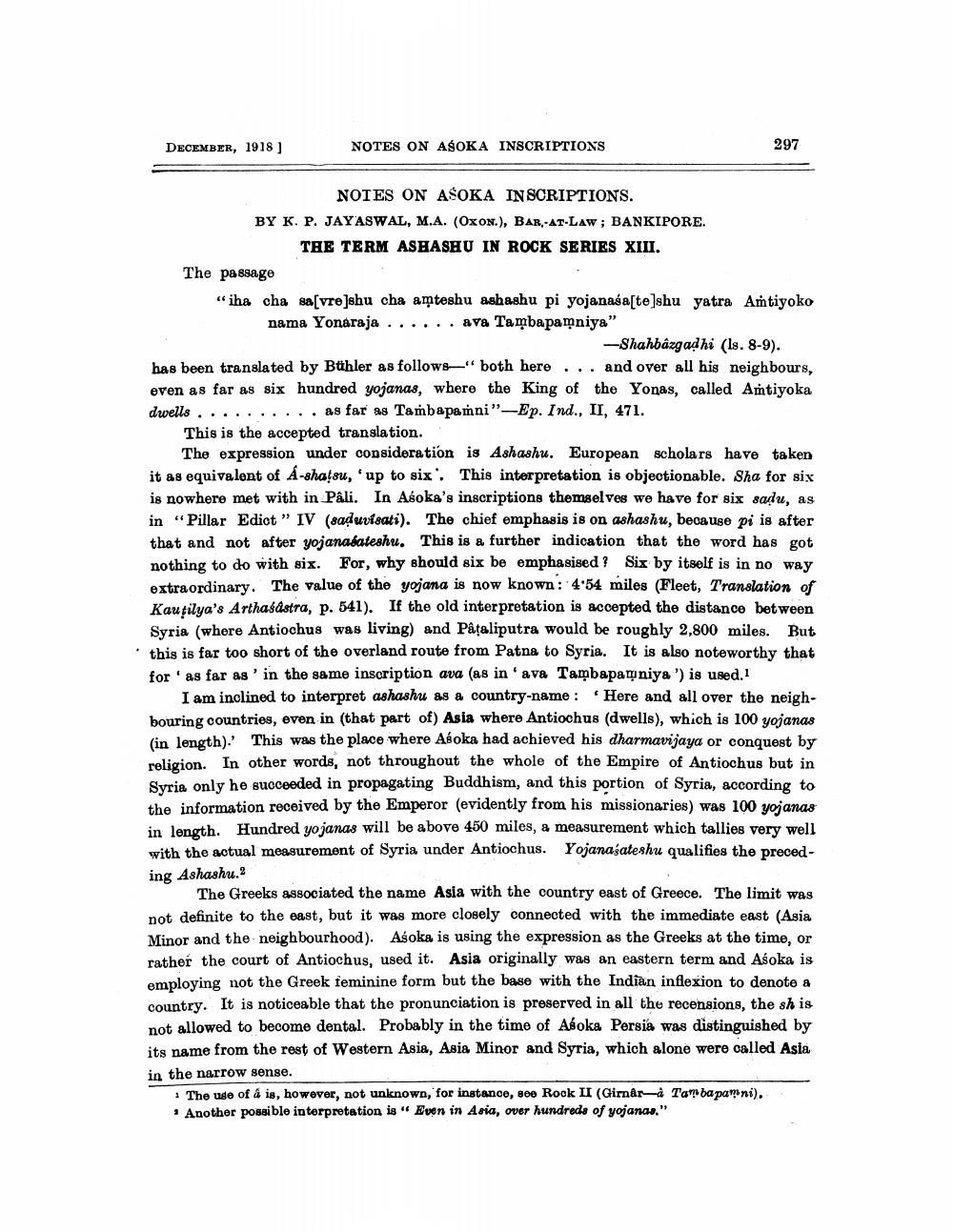________________
DECEMBER, 1918 ]
NOTES ON ASOKA INSCRIPTIONS
297
NOTES ON ASOKA INSCRIPTIONS. BY K. P. JAYASWAL, M.A. (Oxon.), BAR-AT-LAW; BANKIPORE.
THE TERM ASHASHU IN ROCK SERIES XIII. The passage “iha cha sa vre]shu cha amteshu ashashu pi yojanasa[te]shu yatra Amtiyoko nama Yonaraja ...... ava Tambapamniya"
-Shahbazgadhi (ls. 8-9). has been translated by Bühler as follows" both here ... and over all his neighbours, even as far as six hundred yojanas, where the King of the Yonas, called Amtiyoka dwells .......... as far as Tambapani"-Ep. Ind., II, 471.
This is the accepted translation.
The expression under consideration is Ashashu. European scholars have taken it as equivalent of A-shatsu, 'up to six. This interpretation is objectionable. Sha for six is nowhere met with in Pali. In Asoka's inscriptions themselves we have for six sadu, as in "Pillar Edict " IV (saduvísati). The chief emphasis is on ashashu, because pi is after that and not after yojanabateshu. This is a further indication that the word has got nothing to do with six. For, why should six be emphasised ? Six by itself is in no way extraordinary. The value of the yojana is now known: 4:54 miles (Fleet, Translation of Kautilya's Arthasastra, p. 541). If the old interpretation is accepted the distance between Syria (where Antiochus was living) and Påtaliputra would be roughly 2,800 miles. But this is far too short of the overland route from Patna to Syria. It is also noteworthy that for 'as far as 'in the same inscription ava (as in 'ava Tambapawniya ') is used. 1
I am inclined to interpret ashashu as a country-name: 'Here and all over the neighbouring countries, even in (that part of) Asia where Antiochus (dwells), which is 100 yojanas (in length). This was the place where Asoka had achieved his dharmavijaya or conquest by religion. In other words, not throughout the whole of the Empire of Antiochus but in Syria only he succeeded in propagating Buddhism, and this portion of Syria, according to the information received by the Emperor (evidently from his missionaries) was 100 yojanas in length. Hundred yojanas will be above 450 miles, a measurement which tallies very well with the actual measurement of Syria under Antiochus. Yojanašateshu qualifies the preceding Ashashu. 2
The Greeks associated the name Asia with the country east of Greece. The limit was not definite to the east, but it was more closely connected with the immediate east Asia Minor and the neighbourhood). Asoka is using the expression as the Greeks at the time, or rather the court of Antiochus, used it. Asia originally was an eastern term and Asoka is employing not the Greek feminine form but the base with the Indian inflexion to denote a country. It is noticeable that the pronunciation is preserved in all the recensions, the sh is not allowed to become dental. Probably in the time of Asoka Persia was distinguished by its name from the rest of Western Asia, Asia Minor and Syria, which alone were called Asia in the narrow sense.
1 The use of å is, however, not unknown, for instance, see Rock II (Girnar Tamba pamni). 1 Another possible interpretation is "Even in Asia, over hundreds of yojana.."




